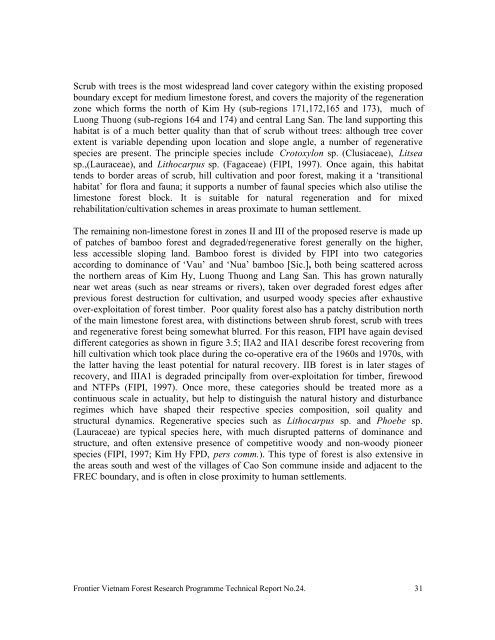Kim Hy Proposed Nature Reserve - Frontier-publications.co.uk
Kim Hy Proposed Nature Reserve - Frontier-publications.co.uk
Kim Hy Proposed Nature Reserve - Frontier-publications.co.uk
Create successful ePaper yourself
Turn your PDF publications into a flip-book with our unique Google optimized e-Paper software.
Scrub with trees is the most widespread land <strong>co</strong>ver category within the existing proposed<br />
boundary except for medium limestone forest, and <strong>co</strong>vers the majority of the regeneration<br />
zone which forms the north of <strong>Kim</strong> <strong>Hy</strong> (sub-regions 171,172,165 and 173), much of<br />
Luong Thuong (sub-regions 164 and 174) and central Lang San. The land supporting this<br />
habitat is of a much better quality than that of scrub without trees: although tree <strong>co</strong>ver<br />
extent is variable depending upon location and slope angle, a number of regenerative<br />
species are present. The principle species include Crotoxylon sp. (Clusiaceae), Litsea<br />
sp.,(Lauraceae), and Lithocarpus sp. (Fagaceae) (FIPI, 1997). Once again, this habitat<br />
tends to border areas of scrub, hill cultivation and poor forest, making it a ‘transitional<br />
habitat’ for flora and fauna; it supports a number of faunal species which also utilise the<br />
limestone forest block. It is suitable for natural regeneration and for mixed<br />
rehabilitation/cultivation schemes in areas proximate to human settlement.<br />
The remaining non-limestone forest in zones II and III of the proposed reserve is made up<br />
of patches of bamboo forest and degraded/regenerative forest generally on the higher,<br />
less accessible sloping land. Bamboo forest is divided by FIPI into two categories<br />
ac<strong>co</strong>rding to dominance of ‘Vau’ and ‘Nua’ bamboo [Sic.], both being scattered across<br />
the northern areas of <strong>Kim</strong> <strong>Hy</strong>, Luong Thuong and Lang San. This has grown naturally<br />
near wet areas (such as near streams or rivers), taken over degraded forest edges after<br />
previous forest destruction for cultivation, and usurped woody species after exhaustive<br />
over-exploitation of forest timber. Poor quality forest also has a patchy distribution north<br />
of the main limestone forest area, with distinctions between shrub forest, scrub with trees<br />
and regenerative forest being somewhat blurred. For this reason, FIPI have again devised<br />
different categories as shown in figure 3.5; IIA2 and IIA1 describe forest re<strong>co</strong>vering from<br />
hill cultivation which took place during the <strong>co</strong>-operative era of the 1960s and 1970s, with<br />
the latter having the least potential for natural re<strong>co</strong>very. IIB forest is in later stages of<br />
re<strong>co</strong>very, and IIIA1 is degraded principally from over-exploitation for timber, firewood<br />
and NTFPs (FIPI, 1997). Once more, these categories should be treated more as a<br />
<strong>co</strong>ntinuous scale in actuality, but help to distinguish the natural history and disturbance<br />
regimes which have shaped their respective species <strong>co</strong>mposition, soil quality and<br />
structural dynamics. Regenerative species such as Lithocarpus sp. and Phoebe sp.<br />
(Lauraceae) are typical species here, with much disrupted patterns of dominance and<br />
structure, and often extensive presence of <strong>co</strong>mpetitive woody and non-woody pioneer<br />
species (FIPI, 1997; <strong>Kim</strong> <strong>Hy</strong> FPD, pers <strong>co</strong>mm.). This type of forest is also extensive in<br />
the areas south and west of the villages of Cao Son <strong>co</strong>mmune inside and adjacent to the<br />
FREC boundary, and is often in close proximity to human settlements.<br />
<strong>Frontier</strong> Vietnam Forest Research Programme Technical Report No.24. 31
















